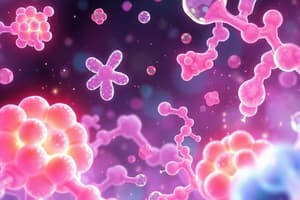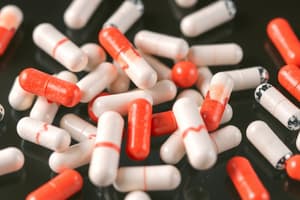Podcast
Questions and Answers
Which type of infections are aminoglycosides usually used to treat?
Which type of infections are aminoglycosides usually used to treat?
- Exclusively gram negative
- Mostly gram negative, some gram positive (correct)
- Equally effective for gram positive and gram negative
- Exclusively gram positive
Why are aminoglycosides not given orally?
Why are aminoglycosides not given orally?
- Due to poor absorption ability (correct)
- High risk of drug interaction
- Increased risk of liver toxicity
- Rapid metabolism in the gastrointestinal tract
What adverse reactions are associated with aminoglycosides?
What adverse reactions are associated with aminoglycosides?
- Neurotoxicity and hematotoxicity
- Nephrotoxicity and ototoxicity (correct)
- Hepatotoxicity and cardiotoxicity
- Gastrointestinal toxicity and respiratory toxicity
How often are aminoglycosides usually administered to enhance synergy?
How often are aminoglycosides usually administered to enhance synergy?
What is the main reason aminoglycosides are not given orally?
What is the main reason aminoglycosides are not given orally?
Which adverse reaction associated with aminoglycosides is usually reversible?
Which adverse reaction associated with aminoglycosides is usually reversible?
In pediatric population, aminoglycosides are commonly used to treat which of the following conditions?
In pediatric population, aminoglycosides are commonly used to treat which of the following conditions?
What is the primary mechanism of action of aminoglycosides?
What is the primary mechanism of action of aminoglycosides?
Which of the following is a bactericidal drug that prevents protein synthesis by binding to the 30S ribosome?
Which of the following is a bactericidal drug that prevents protein synthesis by binding to the 30S ribosome?
What is the primary reason for not administering aminoglycosides orally?
What is the primary reason for not administering aminoglycosides orally?
Which of the following are commonly monitored with aminoglycoside medications?
Which of the following are commonly monitored with aminoglycoside medications?
What are the indications for using aminoglycosides in treating infections?
What are the indications for using aminoglycosides in treating infections?
How often are aminoglycosides usually administered to enhance synergy?
How often are aminoglycosides usually administered to enhance synergy?
Which adverse reaction associated with aminoglycosides is usually reversible?
Which adverse reaction associated with aminoglycosides is usually reversible?
What is a common adverse reaction associated with aminoglycosides that is not reversible?
What is a common adverse reaction associated with aminoglycosides that is not reversible?
Which of the following is a common adverse reaction associated with aminoglycosides that is usually reversible?
Which of the following is a common adverse reaction associated with aminoglycosides that is usually reversible?
What is the primary reason aminoglycosides are not given orally?
What is the primary reason aminoglycosides are not given orally?
How often are aminoglycosides usually administered to enhance synergy?
How often are aminoglycosides usually administered to enhance synergy?
Which of the following is a bactericidal drug that prevents protein synthesis by binding to the 30S ribosome?
Which of the following is a bactericidal drug that prevents protein synthesis by binding to the 30S ribosome?
In pediatric population, aminoglycosides are commonly used to treat which of the following conditions?
In pediatric population, aminoglycosides are commonly used to treat which of the following conditions?
What adverse reaction associated with aminoglycosides is not reversible and not as common?
What adverse reaction associated with aminoglycosides is not reversible and not as common?
Which type of infections are aminoglycosides usually used to treat?
Which type of infections are aminoglycosides usually used to treat?
Flashcards
Aminoglycosides
Aminoglycosides
A class of antibiotics used to treat infections, mainly targeting gram-negative bacteria.
Gram-negative infections
Gram-negative infections
Infections primarily caused by gram-negative bacteria, often treated with aminoglycosides.
Oral administration limitation
Oral administration limitation
Aminoglycosides are not given orally due to poor absorption in the gastrointestinal tract.
Nephrotoxicity
Nephrotoxicity
Signup and view all the flashcards
Ototoxicity
Ototoxicity
Signup and view all the flashcards
Dosing frequency
Dosing frequency
Signup and view all the flashcards
30S ribosome binding
30S ribosome binding
Signup and view all the flashcards
Gentamycin
Gentamycin
Signup and view all the flashcards
Elevated BUN
Elevated BUN
Signup and view all the flashcards
Monitoring serum levels
Monitoring serum levels
Signup and view all the flashcards
Pediatric pneumonitis treatment
Pediatric pneumonitis treatment
Signup and view all the flashcards
Urinary tract infections
Urinary tract infections
Signup and view all the flashcards
Reversible vs Non-reversible
Reversible vs Non-reversible
Signup and view all the flashcards
Poor absorption
Poor absorption
Signup and view all the flashcards
Therapeutic synergy
Therapeutic synergy
Signup and view all the flashcards
Bactericidal drug
Bactericidal drug
Signup and view all the flashcards
Adverse reaction monitoring
Adverse reaction monitoring
Signup and view all the flashcards
Multiple routes of administration
Multiple routes of administration
Signup and view all the flashcards
Gram-positive infections
Gram-positive infections
Signup and view all the flashcards
Study Notes
Aminoglycosides
- Aminoglycosides are usually used to treat life-threatening infections, particularly those caused by Gram-negative bacteria, such as Pseudomonas aeruginosa and Klebsiella pneumoniae.
- Aminoglycosides are not given orally because they are not well-absorbed from the gastrointestinal tract and may cause gastrointestinal disturbances.
Mechanism of Action and Administration
- The primary mechanism of action of aminoglycosides is to prevent protein synthesis by binding to the 30S ribosome, making them bactericidal.
- Aminoglycosides are usually administered every 8 hours to enhance synergy with other antibiotics.
Adverse Reactions
- Aminoglycosides are associated with adverse reactions such as ototoxicity (hearing loss) and nephrotoxicity (kidney damage).
- Ototoxicity is usually not reversible, while nephrotoxicity is usually reversible.
- Aminoglycosides can also cause neuromuscular blockade, which can lead to respiratory failure.
Pediatric Use and Monitoring
- In pediatric population, aminoglycosides are commonly used to treat meningitis, sepsis, and Pseudomonas infections.
- Peak and trough levels of aminoglycosides, as well as renal function, are commonly monitored during treatment.
Studying That Suits You
Use AI to generate personalized quizzes and flashcards to suit your learning preferences.




